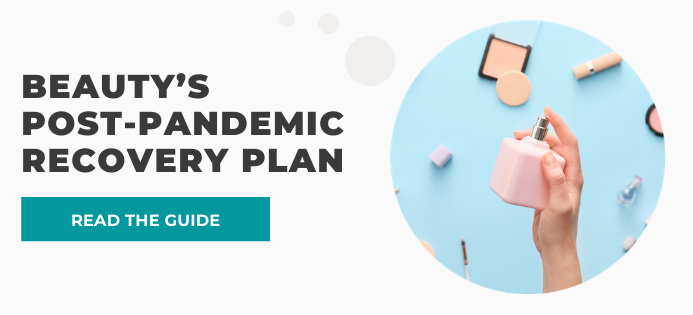On March 4th, ESW hosted a virtual roundtable of beauty e-commerce executives to discuss the latest trends and opportunities. The event was moderated by Marigay McKee, former executive at Estee Lauder, Harrods, and Saks.
The conversation between beauty executives from 12 leading brands revealed several trends currently affecting the industry. These covered changing consumer behaviors, beauty-specific concerns and the decisions facing brands and retailers as they look to adapt to the changing retail landscape.
Retail’s bright spot is online – regardless of geography.
As shoppers spent much of 2020 unable to travel and confined to their homes, the pandemic undoubtedly accelerated the trajectory of cross-border e-commerce growth. What was forecast in 2019 to be a $423 billion market by 2023, is now projected to be worth $736 billion by 2023.[1]
In a recent ESW survey of 22,000 consumers, nearly 70% had made a cross-border purchase in the past six months. The numbers varied across each category, with 88% of respondents having purchased apparel, 65% buying beauty, and 48% having made a luxury purchase. The growth opportunity for brands looking to internationalize is undeniable.
Consumer behavior has changed forever.
As well as magnifying the size of the global e-commerce market, the pandemic also changed the way people shop. With many consumers shopping online for the first time and others becoming more confident engaging with brands virtually, these learned behaviors are unlikely to be forgotten.
After the pandemic, consumers will either remain exclusively online or are going to touch both online and offline channels along their shopping journey. This highlights the need for brands to have a robust omnichannel offering that delivers a consistent experience to their customers across all channels.
An omnichannel fulfilment process is particularly important. Retailers should offer flexible delivery and return options that include BOPIS, curbside and locker pickup, and the ability to return online or in-store. Brands and retailers who fast-track their omnichannel suite of offerings will win more of the market share.
Self-care is the number one beauty trend.
Unsurprisingly, given the volatile state that much of the world has been in, people are prioritizing the care of themselves and their families – all within their own homes. As a result, anti-aging skin care and stress reducing creams have seen continuous growth during the pandemic. This segment is projected to record a 3.8% CAGR and reach $51.8 billion by 2027. The global cosmetic skin-care market is projected to reach $185.5 billion by 2027.[2]
Overnight, millions of shoppers added “hairstylist,” “aesthetician,” “dermatologist,” and “manicurist” to their job descriptions. Now, nearly 9 in 10 Americans now practice some form of self-care, with more than 1/3 of consumers having increased their self-care in the past year.[3]
Bring human interaction back to beauty.
Because of the inability to visit a beauty counter, human interaction has been lost from the buying journey. To fill this void, some beauty retailers are seeing great success by bringing the beauty counter experience online and reintroducing a human element to the transaction. Credo Beauty was able to keep their employees on the payroll during store closures and partnered with live chat platform Hero to facilitate live virtual appointments for customers. According to Hero, online customers who shop using Credo Live are up to 15 times more likely to make a purchase. Sales via the technology now account for 15% of Credo Beauty’s total revenue.[4]
Livestream shopping is another emerging trend that will help brands reach customers in a more human way. Hugely popular in China, it is gaining traction worldwide with global livestream-generated sales expected to double to $120 billion in 2021.
Personalization is priority (and will help reduce returns).
For brands to identify with their customers on a human level they need to establish rapport and build trust. Communicating with customers in a way that is personalized will foster that relationship, increase conversions and promote loyalty.
Beauty purchases are, by nature, a more personal and intimate purchase than many other categories. Tools that enable personalization such as virtual try-on, skin consultation, color-matching etc. put brands in an advantageous position.
Personalization will also help brands to keep their returns rates in check while expanding globally. Beauty brands working with ESW have seen fewer returns where there had been a personalized interaction between the brand and customer prior to purchase, such as via chat or virtual try-on.
Customer data is a brand’s most valuable asset.
Brands and retailers need a detailed understanding of their customers’ wants and needs in order to create that personalized experience. As one person on the call rightly stated, “Quality data is a brand’s most valuable asset, regardless of what they’re selling.”
Storing and managing data can be complicated for brands looking to internationalize due to the differing regulations in each country and region. Working with an expert cross-border solution provider like ESW that can manage these complexities is one solution for brands needing to address these concerns. Otherwise, internal expertise and staffing must be built to ensure compliance.
Don’t choose between native apps and .com.
One shared dilemma for brands on the call was the decision between prioritizing their website experience vs. the in-app experience in optimizing their e-commerce programs.
Several participants agreed that both the website and the app should be fully developed, and that they should interact seamlessly. However, in order for customers to adopt a native app, it must do something functionally worthwhile for them beyond what they get on the website. Because AI/AR experiences work best in a native app environment, that may be the ideal place to host virtual consultations. They are also likely to generate higher order volumes and offer richer customer data.
What brands should instead be asking is how they can support both and have them interact as seamlessly as possible. The reach of omnichannel experiences is set to continue expanding and brands should be adaptable to meet consumers wherever they are.
Marry sustainability with optimal user experience.
While in some cases the pandemic paused sustainable initiatives for companies needing to focus their energies on other risk areas, consumer demand for sustainability is at an all-time high. Seventy percent of all consumers agree that addressing climate change is more important now than ever.[5] . As brands navigate taking incremental steps to meet such demands, it’s critical that they don’t sacrifice user experience.
Many consumers today will try products that align with their values, but what matters most is that the product works! Whether it’s biodegradable packaging or cleaner ingredients in the product itself, if these efforts come at the cost of user experience, quality, and effectiveness, there will be no repeat purchase. The customer will simply go back to their tried-and-true favorites.
Digital experiences continue to evolve.
Trends such as live stream shopping and BOPIS were only emerging pre-pandemic, but were quickly thrust into the mainstream. Now a growing number of technologies to enhance the online shopping experience are popping up quickly.
The beauty executives largely agreed that mobile will remain dominant, but its use will evolve. Today, consumers orchestrate their own digital experiences. One participant predicted that tomorrow, AI will create ecosystems that blend mobile app and website environments to orchestrate an experience personalized to each shopper and their needs.
While the pandemic has forced many brands to adapt, it has also opened up new opportunities as shoppers have developed a stronger interest in self-care, DIY beauty, and buying beauty products online, even across borders. The brands that will thrive in 2021 and beyond are those that can adapt to the new normal of consumer behavior and anticipate those needs with the right product mix, seamless technology, omnichannel fulfilment, clean and sustainable practices, and just the right blend of human touch and social distance.
[1] FORRESTER
[2] ResearchandMarkets.com
[3] Baird & Co.
[4] Econsultancy
[5] MarketWatch

